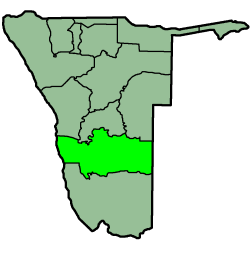Hardap Region
| Hardap Region | |
|---|---|
| Region | |
 Location of the Hardap Region in Namibia |
|
| Country | Namibia |
| Capital | Mariental |
| Government | |
| • Governor | Esme Sophia Isaack |
| Area | |
| • Total | 109,781 km2 (42,387 sq mi) |
| Population (2011) | |
| • Total | 79,000 |
| • Density | 0.72/km2 (1.9/sq mi) |
| Time zone | South African Standard Time: UTC+1 |
Hardap is one of the fourteen regions of Namibia, its capital is Mariental. It is home to the Hardap Dam.
Hardap stretches the entire width of Namibia, from the Atlantic Ocean in the west to Namibia's eastern national border. In the northeast, it borders the Kgalagadi District of Botswana, and in the southeast, it borders the Northern Cape Province of South Africa. Domestically, it borders the following regions:
The Governor of Hardap Region is Esme Sophia Isaack, succeeding Katrina Hanse-Himarwa in 2015. In February 2009, Hanse-Himarwa was condemned by the National Society for Human Rights of Namibia for declaring Hardap Region "SWAPO territory" and urging supporters not to allow other political parties to "invade" the region. In the 2004 Presidential election, the region supported Hifikepunye Pohamba of SWAPO with a narrow majority of the votes (52%), following by Ben Ulenga of Congress of Democrats (21%) and Katuutire Kaura of the Democratic Turnhalle Alliance (16%). Four other candidates combined for the 11%.
The region comprises eight political constituencies:
In the 2015 regional elections Swapo won seven of the eight constituencies with only Rehoboth Urban West narrowly won by the opposition.
Hardap has 55 schools with a total of 21,886 pupils.
According to the Namibia 2001 Population and Housing Census, Hardap had a population of 68,249 (33,665 females and 34,579 males or 103 males for every 100 females) growing at an annual rate of 0.3%. The fertility rate was 3.6 children per woman. 46% lived in urban areas while 54% lived in rural areas, and with an area of 109,651km2, the population density was 0.6 persons per km2. By age, 13% of the population was under 5 years old, 23% between 5-14 years, 55% between 15-59 years, and 8% 60 years and older. The population was divided into 15,039 households, with an average size of 4.4 persons. 34% of households had a female head of house, while 66% had a male. For those 15 years and older, 54% had never married, 30% married with certificate, 1% married traditionally, 9% married concensually, 2% were divorced or separated, and 4% were widowed.
...
Wikipedia
